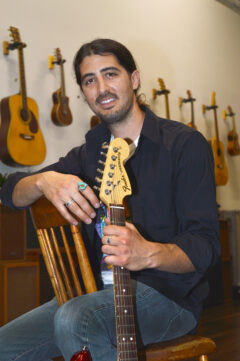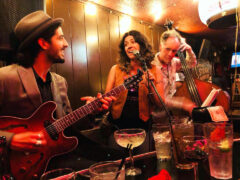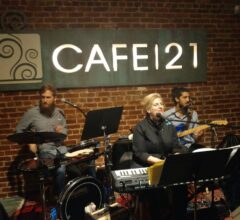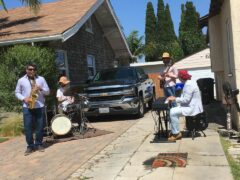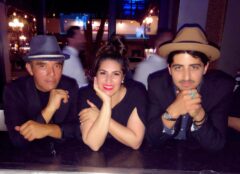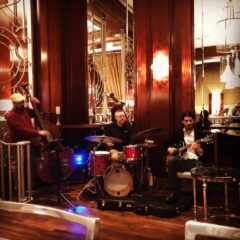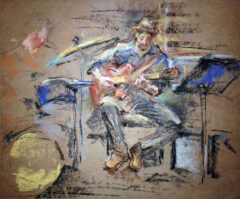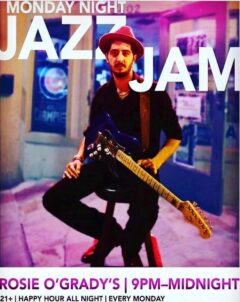Cover Story
Louis Valenzuela: Have You Ever Been to ElectricLOuieLand?
The guitar is the instrument with which I have the most intimate understanding, having played for many years. At one point, I was practicing obsessively, sometimes for more than eight hours a day, and took lessons from Peter Sprague for about a year in the early 1980s. Like a lot of guitarists in the jazz field, I developed a “love/hate relationship” with the instrument, often judging it harshly in comparison to the saxophone, piano, or bass. Consequently, it takes a lot to impress me when it comes to six-string activists.
But the very first time I heard Louis Valenzuela, playing in an ensemble directed by drummer/vibraphonist Nathan Hubbard, I was instantly impressed. Right off the bat, he had the sound. That elusive thing that a player hopes to develop after years of practice and thousands of dollars worth of gear. It is a pursuit where many are called, as the cliché goes, but few are chosen. Louie exuded a warm, liquid legato, super relaxed, and he obviously had something to say. I made several mental notes to keep an eye out for this cat, and, as the intervening years unfolded, the chance to catch Mr. Valenzuela in a wide variety of contexts reinforced my initial impression.
Before the pandemic, Louie was a ubiquitous force on the San Diego music scene, playing everything from church gigs to soul/R&B sessions and leading his own jam session at Rosie O’Grady’s in Normal Heights. After the lockdown, he’s even more involved, mainly through his omnipresent livestreaming service, “ElectricLOuieLand,” (a sly nod to obvious influence Jimi Hendrix’s famous recording studio).
Even through the Covid crisis Valenzuela managed to score an actual live gig every week, playing with trumpeter John Reynolds at Madison on Park in an outdoor, socially distanced context.
“I first met Louie when he was a student at SDSU as he came recommended when I was looking for someone to fill in for a corporate gig. The next time I heard him play (possibly a year or two later), he was hosting a jam session at Rosie O’Grady’s pub in Normal Heights. I was blown away with how quickly he was developing as a young musician. His melodic, harmonic, and rhythmic vocabulary had improved dramatically as had his knowledge base of tunes. I now have the pleasure of playing with him each week at Madison on Park. He is truly a joy with whom to make music and it is evident from the reactions of the patrons that he is loved. His infectious smile, laugh, and sense of swing propels the music forward with integrity and nuance.” —John Reynolds
I’ve watched all of this, quietly, from a distance, gradually compiling a more complete picture of the local phenomenon (the Lakeside-native is just 33 years old) and when the opportunity to learn more about Louie presented itself, I took it.
THE INTERVIEW
San Diego Troubadour: Did you come from a musical family?
Louis Valenzuela: No one in my family plays music.
SDT: What was your childhood like?
LV: I wish I had found music sooner, but what can you do? I went to school and did kid stuff, I guess. I did enjoy surfing but once I found music, I was all in on that.
SDT: Describe your first musical memory.
LV: Honestly the first thing I remember about the guitar is when I was hanging out with a neighbor friend and he had a small, nylon string guitar. He showed me how to play the Alien Ant Farm version of the MJ song, “Annie Are You Okay” with that bass line riff.
SDT: Where did you grow up?
LV: In the East County, (Lakeside, to be exact).
SDT: What kind of music were you digging as a kid?
LV: Well, the first CD I ever bought was from Sam Goody and it was Boyz to Men’s Evolution, and I literally have it in my car right now after finding it recently at my parent’s house before they moved out of state last year. I remember listening to a Michael Jackson CD compilation called Past, Present, Future that my parents had also. It was a four-CD set, if I remember correctly, that had a bunch of different MJ tunes on it. But I was also really into rock ‘n’ roll. The first concert I ever went to was a Metallica concert at the Sports Arena. I was into Metallica, then AC/DC, then Led Zeppelin until I discovered Jimi Hendrix. Once I made it to Jimi, I was hooked. Seriously, I think all Hendrix albums are pure gold. He’s my number one.
SDT: So, guitar was your first instrument?
LV: Yes. It was really from my neighborhood friend, Kevin. He is the one that introduced me to the guitar and then we had a shitty garage band together.
SDT: When did jazz come into the picture?
LV: It was when I went to college. I knew that if I was gonna go to college, I was going to study something that I actually had an interest in. I was over school at that point, so I knew that the only way I could make it was if I did music. But at this point I wasn’t at all ready to be studying music on a college level. I mean, I could barely read music and had never heard of jazz. When I went to audition all they had was classical or jazz. And I knew nothing of either. I auditioned for both even though I knew I was going to blow the auditions, which I did. I mean, I’m sitting there, never having played a classical piece in my life, getting slammed in an audition with a steel-string guitar, ha ha. Obviously in classical music they use nylon-string guitars. The classical department accepted me and the jazz did not. And for some reason, I knew that I had to study jazz. The only thing I remember is auditioning with “All Blues,” or some other standard. And when it came time to improvise I tried to, but at this point I had no idea what I was doing. And when they had me sight read… talk about bombing. I had never listened to jazz up until this point. I remember finding [Miles Davis’] Bitches Brew album and thinking “WTF is this?” I thought it was great and interesting, but I had no idea what was going on. Like what are they doing and how do they know what to play and when and who’s doing what? I mean I was so lost. And what a record to come into jazz with, ha ha. Looking back, it’s hilarious. I did know that I liked the soloing because it reminded me of what Hendrix was doing. So, in that sense I nailed it because I could just tell that the jazz players knew what they were doing.
“I have enjoyed seeing Louie Valenzuela become one of San Diego’s top guitarists. He’s an excellent guitarist, composer, recording studio engineer and more. He’s also a genuinely nice person and very dedicated to his art. He has contributed greatly to our music community through his ElectricLOuieLand live stream broadcasts. Offering top quality video and sound to help local artists stream and promote their work.”
—Rob Thorsen
SDT: At what point did you consider you might be playing music for a living?
LV: I would say when I was studying music in college. I knew I had a long way to go but I knew that I wanted to pursue music.
SDT: Can you describe the arc of your musical education when it comes to the guitar?
LV: Well, I would say it started out with a garage band mentality, then I had some private lessons at a local music school in El Cajon, which made me really interested in learning more about music for real. So, I decided to try and study it in college. I failed a bunch at first, but then I made it through. When I say I was new to jazz, I mean new. I failed the audition to get into the jazz program—three times I think—but I just signed up for all the classes a jazz major was supposed to take anyway. Then I just busted my ass and studied hard at home when I wasn’t at school. Once I got my undergrad I knew that I still couldn’t play. I mean, it’s not like you’re guaranteed to come out of music school sounding like [Pat] Metheny anyway. It’s different for everyone. I was surrounded by people in school that had been studying jazz since they were little or were in high school band or something. So, their introduction to theory and harmony and improvising was way ahead of mine. How are you supposed to know something that you don’t know, or even didn’t know existed in the first place? So, once I got my undergrad I basically just studied music on my own for the next ten years. My goal was to get gigs and actually try to be a working musician. I did a lot of teaching for young kids at different local schools, but I wasn’t gigging a lot. So, I literally just played and practiced as much as I could, using all the knowledge that I got from my undergrad and from my musical peers. Over the years I started to make gigs for myself since I knew that was the only way to really learn. You have to do. So, slowly I got more gigs and was able to book my own things just to have a reason to play.
Later, there was a crucial moment where I got a church gig from a friend of mine [Jacob “Cubby” Miranda]. I had never listened to that kind of music before in my life. A few years later I moved to another church and I’m still there. This is the point in my life where I really relearned music. Before that it was very analytical, scholastic, and quantitative, which is fine and I get why they do that in school, but it’s completely opposite of the jazz ethos. Once I got my church gig and really started to learn music and communicate like they do in the church scene, it all really started to come together for me. It was the opposite of school; I was learning by ear with absolutely no written music and a completely different way of talking about music. I wasn’t able to communicate with church musicians the same way I did in school. We didn’t talk about chords and theory, it was about playing. So, I had to relearn how to play from an aural perspective, which, if we are being truthful, is what all the jazz greats did. Historically speaking, this is how and where the music of jazz comes from. I could tell the mentality was the same. I got to play the electric guitar and it felt like I was playing Hendrix every Sunday. I started to really hear everything and was getting better at my musical memory. Like I said, nothing is written down, so it’s all learning from recordings and being open to improvising with the structure in the moment with these church musicians. And it started to help my playing and hearing of music in general immensely. It was the combination of all the different worlds of music combined into one, and I love it! At this point I was gigging all week, not really teaching any more, running a successful jazz jam at Rosie O’ Grady’s, and playing my church gig every week. This was ten years after my undergrad and then I decided to get my masters in 2020, basically right as Covid came about. I also got hired at SDSU to replace the one and only Bob Boss, my mentor and friend. I took over for him at SDSU and Mesa College, so I’m in the jazz faculty at both.
“I first met Louie Valenzuela several years back when he came to me as a student. He really hadn’t heard much jazz yet but he made up for lost time right away. He had a good combination of curiosity, enthusiasm, and dedication that brings results. After earning his B.A. at SDSU, he gained a great deal of invaluable real-,world experience. Soon, he became a leader and has since contributed to the local music scene in many ways. His steady Monday night Jam Session was a favorite hang. When he returned to work on his M.A. he studied with me again and also studied bass with Bob Magnusson. He finished his work during the pandemic last year and embraced the necessary technology and kept at it until he found yet another voice as a host of ElectricLOuieLand live stream concerts. So, as a player, leader, composer and producer he has shown himself to be, truly, a voice above the crowd.”
—Bob Boss
SDT: Are you a “guitar collector?” Do you have a favorite instrument?
LV: My main axe is a Gibson ES 135 for jazz gigs; for everything else I use my Fender Strat.
SDT: What would you say (style-wise) is your favorite music to play?
LV: Jazz, R&B/soul, blues, rock ‘n’ roll.
SDT: Describe a typical week of music for Louis Valenzuela before the pandemic.
LV: Monday: Lead my jazz jam at Rosie’s.
Tuesday: Lead my R & B/Soul jam at the Riviera Supper Club and sometimes play with Charlie Arbelaez afterward.
Wednesday: Possibly gig, then head to the Gilbert Castellanos jam at Panama 66.
Thursday: Often play the Latin jazz jam in Barrio Logan if I don’t have another gig.
Friday: I usually have a gig.
Saturday: I usually have a gig.
Sunday: Church gig. Do another one or possibly hit a jam session.
SDT: What do you teach at Avant Garde Music Studios?
LV: I do teach a little bit. I am usually teaching all the more advanced students. I’m even thinking about starting a jazz program there, possibly streaming out of ElectricLOuieLand. I am usually in the studio there after hours or streaming. Antonio Grajeda, a good friend of mine, was gonna open a place up to teach his roster of music students and wanted to know if we wanted to be a part. For us by us, you know? A type of community hub for students and artists run by locals. So, I invested some money into it as a partner and founder and helped open the place up. We offer online and in-person lessons, along with recording time and studio space for rehearsing and all multimedia productions. The fact that we made it through the pandemic is a miracle. Antonio is really holding that place together. We totally had to pivot but we made it through and are back at it stronger than ever. We offer online and in-person lessons, along with recording time and studio space for rehearsing and all multimedia productions.
SDT: What do you hope to pass on to your students?
LV: I hope they understand how to really learn and hear music in terms of where the music comes from and how it was made. When I was getting my masters, I wrote a whole paper on this idea. Which is basically what I did in my career of learning what I spoke of earlier.
SDT: In the next five years, where do you hope to be?
LV: I hope to have released some of my music and be gigging more seriously. Hopefully, that means I can do more traveling. I would also love to be able to play as a leader or sideman for something that isn’t just jazz. Something maybe more mainstream.
SDT: How did “ElectricLOuieLand” come about?
LV: Well, it really came from my jam session at Rosie’s. There was a point where I would live stream each session from my phone on Instagram. Then, once Covid hit I was stuck in my house all day. I thought about doing some solo live guitar streams just to have something to do and make some money if possible. My girlfriend Jessi and I started doing duo sets on Instagram, and she’s a great singer. Then I realized I had all the gear to mic everything up and really try to send good audio and I had the studio just sitting there down at AGMC. That’s where it really began. I went down a rabbit hole of streaming and got cameras and did a lot of research online and trial and error. I would have a few people come down to do basically Rosie’s down at Avant Garde. Then I just became more and more obsessed with making the stream better with more camera angles and better audio and the ability to broadcast it on multiple social media sites. I spent hours and hours on it. I also thought this was the best way for some of my musician friends to make some money during a year of no gigs. So, that’s what I did. I ended up getting the stream dialed in eventually and even got to team up with Gilbert Castellanos and started the Anthology series with him. If you go to YouTube you can see the progression of the stream and it’s hilarious. I was reaching out to all sorts of people that I knew, not just in the jazz scene. I also lost a dear friend in a car accident, Nina Deering, this past year in the beginning of Covid. I had some videos of her and I up on my YouTube channel, which became so valued to me and a bunch of other friends and family of her. It was nice to be able to have these few videos of her online and accessible anytime. So, really, the stream started as a means to help my peers play and make some money through Covid when there were no gigs but also, if nothing else, it offered me a way to document the scene here in San Diego. At this point I thought was important to do since I had just lost my friend who I was very close to musically. The scene here in San Diego is one of a kind too. So, I thought it would be great to document everyone and I’m still working on it. Those roots run deep! Obviously ElectricLOuieland is an homage to Jimi Hendrix. The last recordings that he had control over were recorded at his personal studio that he had built, which was called Electric Ladyland. And I’m such a huge fan of Jimi that it just kind of hit me one day to call it ElectricLOuieLand in honor of Jimi. And it worked well with it being all digital and stuff, so the name really reflected what is actually happening.
SDT: In what ways has the pandemic affected you as an artist?
LV: Well, it has made me really go into the digital world. I had been wanting to do this already, but the situation forced me to forge ahead full on.
“Louie Valenzuela has a great tone, beautiful harmonic concept and is super fun to play with. I have had the pleasure of doing numerous gigs with him over the years, and no matter if it’s a trio or one of my huge projects. We always have fun and laugh a lot. It has been great to see him grow into an important voice in the scene, first with his jam session and now with his live streams.”
—Nathan Hubbard
SDT: As work begins to open back up, what are you looking forward to?
LV: I’m looking forward to be back playing with my peers, but I’m also looking forward to doing the stream. What was missing when we live-streamed was the audience and that connection. It’s great getting to see everyone online, especially when they are from all over the world, but I think it’s going to be the best of both worlds when I can start playing live shows with an audience and be able to live stream it as well. I am also looking forward to meeting up with people to do the ElectricLOuieLand podcast in person. I started the podcast to be able to sit down with people that I admire like Peter Sprague, Gilbert Castellanos, and Christopher Hollyday and just chat with them. I am a big fan of podcasts and digital media in general so I felt it would be able to contribute in a way that is unique to me, in this case, through music. I’m also planning to launch some instructional videos on ElectricLOuieLand through YouTube.
SDT: What do you love most about music?
LV: Everyone loves music. It really is the universal language. The more and more I study it, the more and more I am convinced it’s like magic.
SDT: Anything you’d like to add?
LV: Thanks to all the greats that came before me. It is on your shoulders that we stand. Hendrix for life!!
You can catch up with Louis on YouTube, Twitch, Facebook, and Instagram all @ElectricLOuieLand… ElectricLOuieland.com is an easy, one-stop shop for all these platforms. The Gilbert Castellanos jam session at Panama 66 is live streamed every Wednesday. Jazz 88 rebroadcasts the stream every Saturday at 5pm in a series called “Jazz Night in San Diego.”






